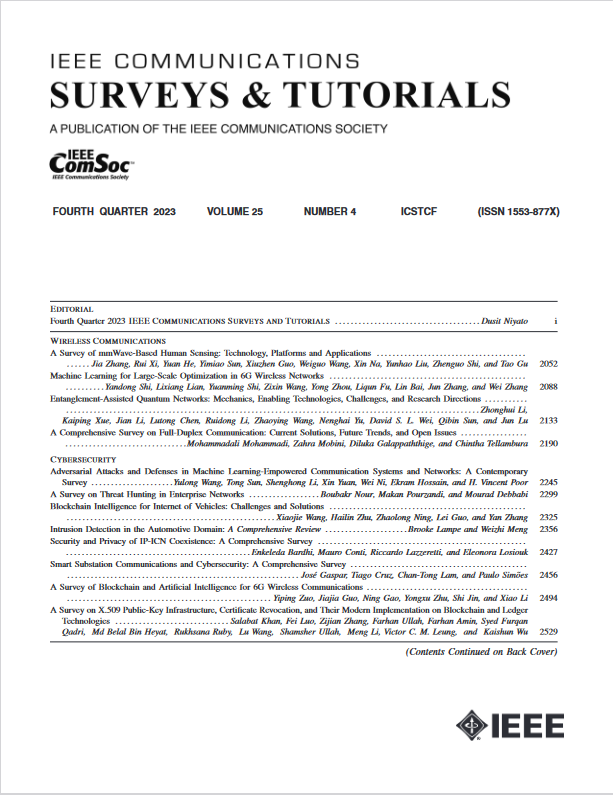机器学习时代的物理层认证和安全设计
IF 34.4
1区 计算机科学
Q1 COMPUTER SCIENCE, INFORMATION SYSTEMS
引用次数: 0
摘要
物理层(PHY)安全是无线系统的一个突出研究课题,而机器学习(ML)正在成为提供新的数据驱动安全解决方案的有力工具。因此,在越来越多的数据驱动型无线服务中,将 ML 技术应用于物理层安全至关重要。在此背景下,我们首先总结了非常适合无线安全的定制 ML 算法系列。然后,我们回顾了 ML 辅助 PHY 安全的最新进展,其中 "PHY 安全 "一词分为两种不同类型:i) PHY 身份验证和 ii) 安全 PHY 传输。此外,我们将 NNs 视为特殊类型的 ML,并介绍了如何使用 NNs 处理 PHY 安全优化问题。最后,我们指出了通过应用精心定制的 ML 工具应对 PHY 安全挑战的一些主要挑战和机遇。本文章由计算机程序翻译,如有差异,请以英文原文为准。
Physical Layer Authentication and Security Design in the Machine Learning Era
Security at the physical layer (PHY) is a salient research topic in wireless systems, and machine learning (ML) is emerging as a powerful tool for providing new data-driven security solutions. Therefore, the application of ML techniques to the PHY security is of crucial importance in the landscape of more and more data-driven wireless services. In this context, we first summarize the family of bespoke ML algorithms that are eminently suitable for wireless security. Then, we review the recent progress in ML-aided PHY security, where the term “PHY security” is classified into two different types: i) PHY authentication and ii) secure PHY transmission. Moreover, we treat NNs as special types of ML and present how to deal with PHY security optimization problems using NNs. Finally, we identify some major challenges and opportunities in tackling PHY security challenges by applying carefully tailored ML tools.
求助全文
通过发布文献求助,成功后即可免费获取论文全文。
去求助
来源期刊

IEEE Communications Surveys and Tutorials
COMPUTER SCIENCE, INFORMATION SYSTEMS-TELECOMMUNICATIONS
CiteScore
80.20
自引率
2.50%
发文量
84
审稿时长
6 months
期刊介绍:
IEEE Communications Surveys & Tutorials is an online journal published by the IEEE Communications Society for tutorials and surveys covering all aspects of the communications field. Telecommunications technology is progressing at a rapid pace, and the IEEE Communications Society is committed to providing researchers and other professionals the information and tools to stay abreast. IEEE Communications Surveys and Tutorials focuses on integrating and adding understanding to the existing literature on communications, putting results in context. Whether searching for in-depth information about a familiar area or an introduction into a new area, IEEE Communications Surveys & Tutorials aims to be the premier source of peer-reviewed, comprehensive tutorials and surveys, and pointers to further sources. IEEE Communications Surveys & Tutorials publishes only articles exclusively written for IEEE Communications Surveys & Tutorials and go through a rigorous review process before their publication in the quarterly issues.
A tutorial article in the IEEE Communications Surveys & Tutorials should be designed to help the reader to become familiar with and learn something specific about a chosen topic. In contrast, the term survey, as applied here, is defined to mean a survey of the literature. A survey article in IEEE Communications Surveys & Tutorials should provide a comprehensive review of developments in a selected area, covering its development from its inception to its current state and beyond, and illustrating its development through liberal citations from the literature. Both tutorials and surveys should be tutorial in nature and should be written in a style comprehensible to readers outside the specialty of the article.
 求助内容:
求助内容: 应助结果提醒方式:
应助结果提醒方式:


